
Spring Semester, 2001
Introduction
© 2001, All Rights Reserved, SDSU & Roger Whitney
San Diego State University -- This page last updated 30-Jan-01

|
CS 635 Advanced Object-Oriented Design & Programming Spring Semester, 2001 Introduction |
|
|---|---|---|
|
© 2001, All Rights Reserved, SDSU & Roger Whitney San Diego State University -- This page last updated 30-Jan-01 |
Reading Assignment
For Tuesday, February 6
Abstraction, Encapsulation, and Information Hiding, by Berard, http://www.toa.com/pub/abstraction.txt
Object Coupling and Object Cohesion, chapter 7 of Essays on Object-Oriented Software Engineering , Vol 1, Berard, Prentice-Hall, 1993. Read pages 72-92. This chapter is on reserve at Love Library and at Cal Copy.
Be prepared to discuss these in class.
Prerequisites for the Class
CS 535 and working knowledge of C++, Java, or Smalltalk
Since very few enrolled students in 635 have taken 535 there will be a test in class on Thursday February 1. The test is only for those that have not taken 535 at SDSU. If you have taken 535 there is no need to show up for class on Thursday. If you are currently enrolled in 635 and have not taken 535 you must take this test. If you fail the test you will not be allowed to remain in the class.
Meyer's Criteria for Evaluating for Modularity
Decomposability
Decompose problem into smaller subproblems
that can be solved separately
Example: Top-Down Design
Counter-example: Initialization Module
Meyer's Criteria for Evaluating for Modularity
Composability
Freely combine modules to produce new systems
Examples: Math libraries
Unix command & pipes
Meyer's Criteria for Evaluating for Modularity
Understandability
Individual modules understandable by human reader
Counter-example: Sequential Dependencies
Meyer's Criteria for Evaluating for Modularity
Continuity
Small change in specification results in:
Changes in only a few modules
Does not affect the architecture
Example: Symbolic Constants
const MaxSize = 100
Meyer's Criteria for Evaluating for Modularity
Protection
Effects of an abnormal run-time condition is confined to a few modules
Example: Validating input at source
Principles for Software Development
KISS Keep it simple, stupid
Supports:
| Language | Lines of Code |
| Smalltalk | 8 |
| C++ | 24 |
Applications of Principles
First program:
class HelloWorldExample { public static void main( String args[] ) { System.out.println( "Hello World" ); } }
Grow programs

What is Object-Oriented Programming
Language Level Definition
Conceptual Level Definition
Language Level Definition of OOP
Object
Language Level Definition of OOP
Class
Language Level Definition of OOP
Inheritance
Conceptual Level Definition of OOP
Abstraction
“Extracting the essential details about an item or group of items, while ignoring the unessential details.”
Edward Berard
“The process of identifying common patterns that have systematic variations; an abstraction represents the common pattern and provides a means for specifying which variation to use.”
Richard Gabriel
Example
Pattern: Priority queue Essential Details: length items in queue operations to add/remove/find item Variation: link list vs. array implementation stack, queue
Conceptual Level Definition of OOP
Encapsulation
Enclosing all parts of an abstraction within a container
Example 
Conceptual Level Definition of OOP
Information Hiding
Hiding parts of the abstraction
Example 
Conceptual Level Definition of OOP
Hierarchy
Abstractions arranged in order of rank or level
Class Hierarchy 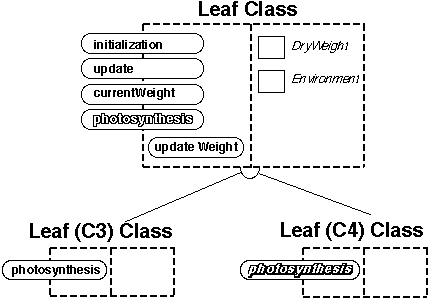
Conceptual Level Definition of OOP
Hierarchy
Object Hierarchy
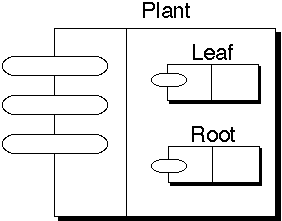
Some Heuristics
A class should capture one and only one abstraction
Heuristics Continued
Beware of classes that have many accessor methods defined in their public interface. Having many implies that related data and behavior is not being kept in one place.
class test { private int thisData; private int thatData; private float moreData; public void setThisData( int data ) { thisData = data; } public void setThatData( int data ) { thatData= data; } public void setMoreData( int data ) { moreData= data; } public void getThisData( ) { return thisData; } public void getThatData( ) { return thatData; } public void getMoreData( ) { return moreData; } public String toString() { // code deleted } }
No work is being done in this class.
Other classes are getting the data in class test and performing some operation on it.
Why is this class not doing the work on the data!
Who is doing the work?
The God Class Problem
Distribute system intelligence horizontally as uniformly as possible, that is, the top-level classes in a design should share the work uniformly.
Do not create god classes/objects in your system. Be very suspicious of a class whose name contains Driver, Manager, System, or Subsystem
Beware of classes that have too much noncommunicating behavior, that is, methods that operate on a subset of the data members of a class. God classes often exhibit much noncommunicating behavior.
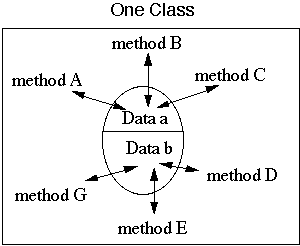
Divide noncommunicating behavior into separate classes

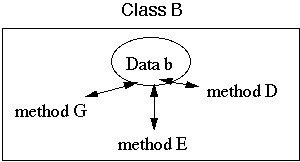
The God Class Problem - Data Form
Legacy Non-OO System
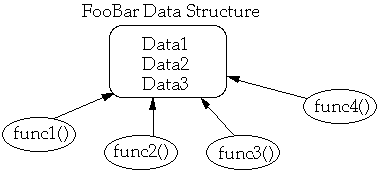
Poor Migration to OO System 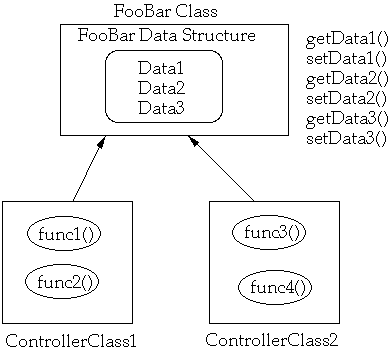
Proliferation of Classes Problem
Be sure that the abstractions that you model are classes and not simply roles object play
Do we use a Father class, Mother Class, and a Child class to model a family?
Or do we use a Person class, with Person objects acting as Father, Mother and Child?
Do not turn an operation into a class.
Be suspicious of any class whose name is a verb or is derived from a verb, especially those that have only one piece of meaningful behavior ( i.e. do not count sets, gets, prints).
Multiple Inheritance
6.1 If you have an example of multiple inheritance in your design, assume that you have made a mistake and prove otherwise.
Multiple inheritance is not bad
Multiple inheritance is much rarer than many people think
Multiple inheritance is often overused
Single Inheritance
Parent classes should not know anything about their child (and grandchild, etc.) classes.
All data in a parent class should be private to the child class
In practice inheritance hierarchies not be shallow, and not more than about 6 levels deep
Metrics Rules of Thumb [2]
Upper bound for average method size
| Language | LOC | Statements |
| Smalltalk | 8 | 5 |
| C++ | 24 | 15 |
Metrics Rules of Thumb
The average number of comments lines per method should be greater than 1
The number of problem reports per class should be low
C++ will have 2 to 3 times the lines of code of Smalltalk
Code volume will expand in the first half of the project and decline in the second half, as reviews clean up the system
[1]Suggested by Mark Lorenz in Object-Oriented Software Development: A Practical Guide page 185
[2]These are found in [Lorenz, 1993]. These rules of thumb are based on Lorenz's experience as a consultant.
Copyright ©, All rights reserved.
2001 SDSU & Roger Whitney, 5500 Campanile Drive, San Diego, CA 92182-7700 USA.
OpenContent license defines the copyright on this document.
visitors since 30-Jan-01 Next